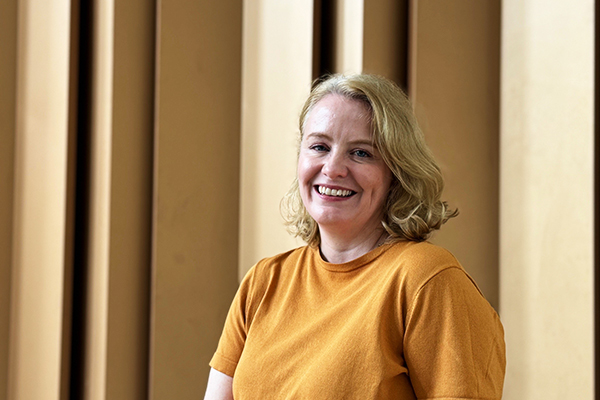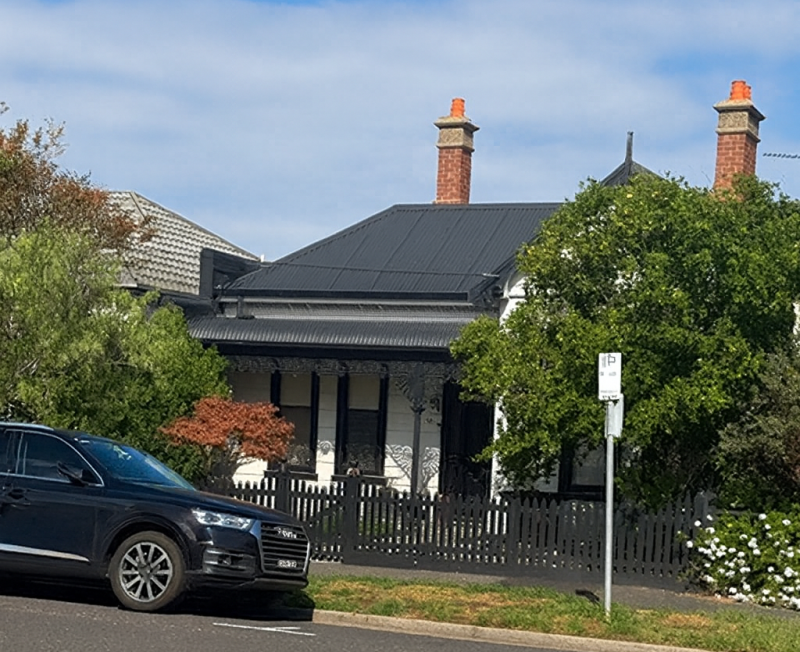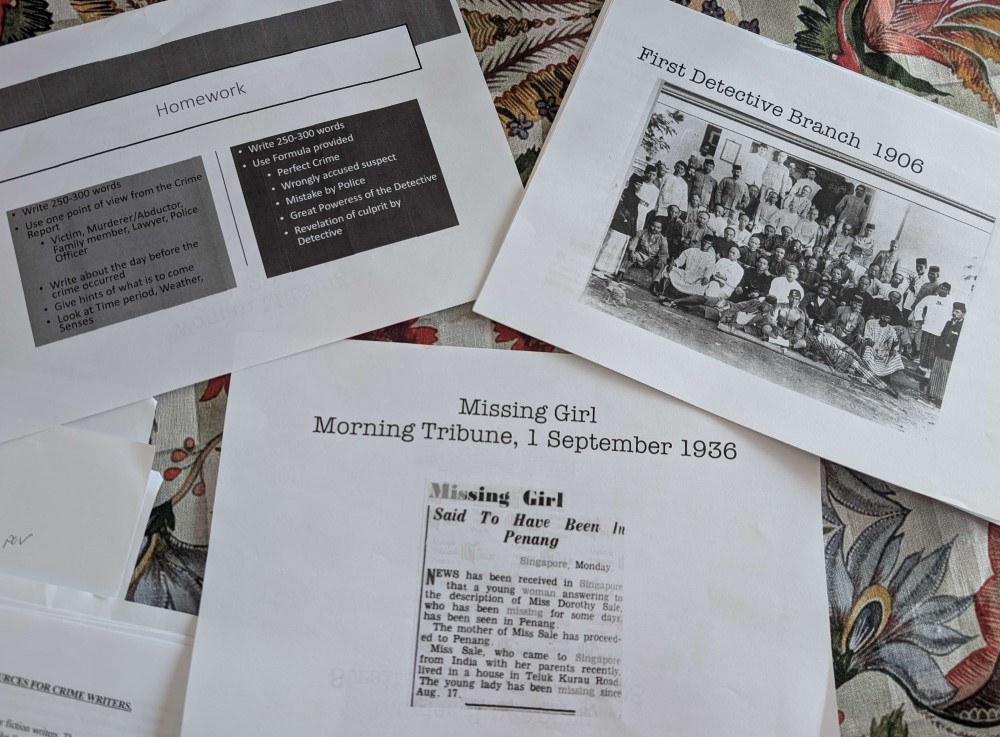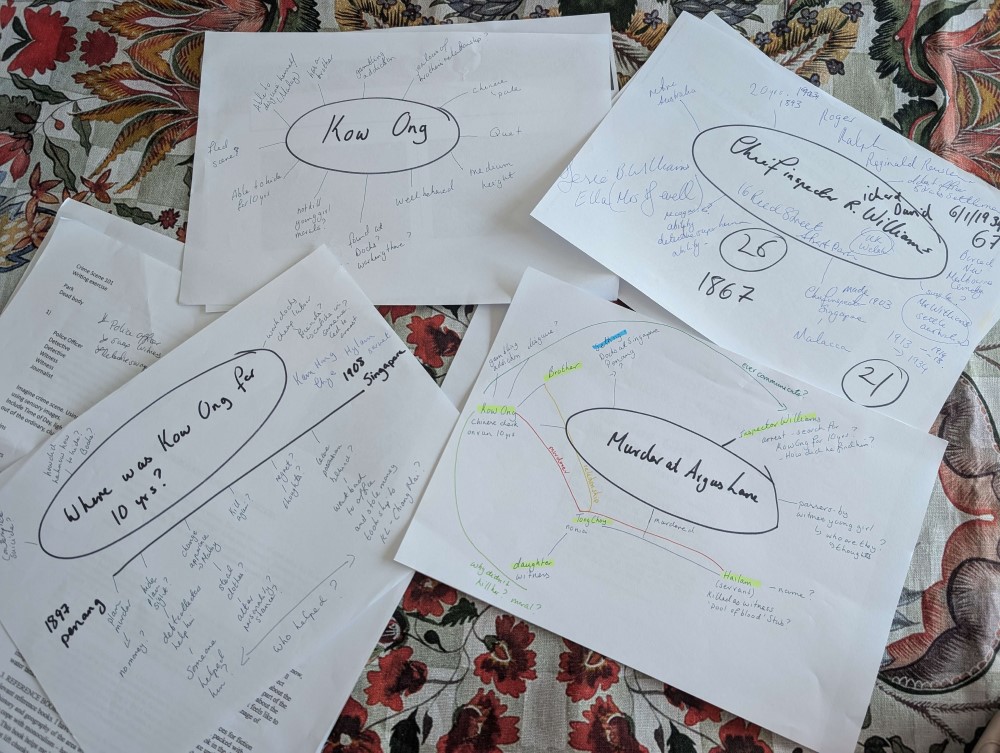Echoes from the Archives: Where Memories and Mystery Meet
Where past traumas echo in oral testimonies, writer Tracey Morton discovers both a window into Singapore’s haunting past and inspiration for her crime fiction novel, Someone Is Coming (Monsoon Books, 2022).
By Ruth Wee
13 November 2025
 Tracey Morton, 2025. Photo by Jimmy Yap.
Tracey Morton, 2025. Photo by Jimmy Yap.Most of the time, the archivists of the National Archives of Singapore (NAS) play a quiet supporting role in the background. They collect and preserve records – documents, papers, photographs and oral history testimonies – that are used by researchers.
But in Tracey Morton’s 2022 novel, Someone Is Coming, an oral history interviewer moves to centre stage as an important protagonist, helping to set in motion a gripping piece of crime fiction set in Malaya at the turn of the 20th century.1
 Someone Is Coming (Monsoon Books, 2022) at the Singapore Alcove at the Central Public Library. Photo by Ruth Wee.
Someone Is Coming (Monsoon Books, 2022) at the Singapore Alcove at the Central Public Library. Photo by Ruth Wee.Using Oral Testimonies
Heavily inspired by life in the early 20th-century Malayan plantations, Someone Is Coming puts a fictional spin on this haunting period in history. Born from hours going through at least 16 oral history testimonies2 as well as related newspaper reports,3 the narrative unfolds through an oral history interview – “an interesting way to tell a story”, as Tracey describes it. Though grounded in meticulous archival research, Tracey gave her imagination free rein in crafting the fictional elements of her story. It revolves around nonagenarian Philip Goundry’s recollections of his childhood in Malayan plantations, elicited by Dr Lin, an oral history interviewer whose questioning sometimes bordered on intrusive.
Patience, pragmatics and paralinguistic cues are quintessential in oral histories – elements Tracey wove throughout her novel. Tension between the protagonists revealed their distinct personalities. Under a veil of politeness, Dr Lin emerged as direct, persistent and slightly aggressive while Philip was a reticent man who had emotional outbursts when dangerous memories were unlocked. Through their interactions, Tracey captured the dynamics of real oral history interviews.
Speaking to a neuroscientist, Tracey learnt that traumatic events experienced as a child can be suppressed and recreated to cope with past tragedies. This played out as Philip recounted his tales from memory, with contradictions in his account revealing the limitations of human memory and unconditional reliance on personal testimonies.
While Philip’s firsthand accounts shed light on the dark period of the early 20th century, more critical were omissions, outbursts and moments of hesitation resulting in half-truths. As memories were unlocked and secrets unravelled, newspaper clippings and photographs that Dr Lin brought along to the interview sessions further challenged Philip’s factoids, exposing the unreliability and fragility of recollections.
Interest in Archival Materials
Tracey’s fascination with Malayan plantations germinated while researching an essay for her master’s degree on crime and thriller writing at the University of Cambridge on whether Somerset Maugham’s short stories from the East could be considered crime fiction. Knowing that Maugham drew inspiration from real life, she began scouring the collections of the NAS and the National Library Singapore to trace the links between murders in his stories and the past, meticulously piecing together reported crime cases.
She is definitely no stranger to the library and the archives, having pored through countless oral history testimonies, newspaper clippings and even historical records like death notices in the past 11 years. Akin to digging through digital treasure troves, these have led to unexpected finds.
“I went through different rabbit holes and found other stuff that [were] interesting”. Through newspaper snippets and obituaries, Tracey discovered a case involving Richard David Williams, former Chief Inspector of police in the Straits Settlements, and this became her favourite. Williams had apparently recognised a Chinese man disguised as a Malay in Tanjong Pagar, who had been on the run for more than 10 years after killing a Peranakan woman and her servant in 1897.4 “This really sparked my imagination as he was dressed as a Malay and he still managed to identify him, very Sherlock Holmes,” she remarked.
And with passion came obsession. “I actually found out where he’s buried,” Tracey fondly recalled a side quest that found her outside Detective Williams’ former residence in Melbourne, Australia, in April 2025. “There was a dog and it’s just right down… by the beach. We went in Easter. My poor husband – I dragged him around to these crazy places and I took photos… it was really amazing.”
 The presumed former residence of Detective Richard David Williams in Melbourne, April 2025. Photo by Ruth Wee.
The presumed former residence of Detective Richard David Williams in Melbourne, April 2025. Photo by Ruth Wee.While still images and text provide the necessary facts, oral testimonies flesh out the thoughts, feelings and raw emotions of people recounting their stories.
 Screengrab of a newspaper obituary for Detective Richard David Williams who died on 5 January 1934. Image from Trove, National Library of Australia.
Screengrab of a newspaper obituary for Detective Richard David Williams who died on 5 January 1934. Image from Trove, National Library of Australia.The Usefulness of Historical Materials
Oral history accounts and old newspaper reports have been valuable mines of information not only for Tracey, but for budding writers that she mentors as well.
In her crime fiction-writing class with the Singapore Book Council in 2023, she introduced participants to creating crime fiction stories through research informed by historical materials. Working in small groups, participants examined cold cases from newspaper reports, listened to oral testimonies and brainstormed story ideas. With information scattered across different sources, aspiring writers had to piece them together. “That’s the best thing about the archives,” Tracey quipped, “It makes you into a detective.”
 A newspaper report of a missing person case and a 1906 photograph of Singapore's first detective branch are some of the materials used at Tracey's crime writing workshop with the Singapore Book Council in 2023. Photo by Ruth Wee.
A newspaper report of a missing person case and a 1906 photograph of Singapore's first detective branch are some of the materials used at Tracey's crime writing workshop with the Singapore Book Council in 2023. Photo by Ruth Wee.Participants were tasked to write from different perspectives – ranging from journalist to witness, from victim’s relative to even the victim’s ghost. One participant uncovered accounts of the Red Butterfly Gang, or Ang Hor Tiap in Hokkien, an all-girl gang that terrorised Singapore with violence, intimidation and extortion from the late 1950s to the 1970s. As their name suggests, members wore red butterfly tattoos on their thighs, or sometimes on the shoulder or groin.5 They were among the many gangs that rocked Singapore’s history and left their footprints in the archives.
 Some of Tracey’s research and brainstorming materials. Photo by Ruth Wee.
Some of Tracey’s research and brainstorming materials. Photo by Ruth Wee.Just as Someone Is Coming drew inspiration from the library and archives, Tracey encourages writers to tap into their vast resources. “[The story is] pretty much all out for you. The crime is there; the characters are there… The story is just there waiting to be written.”
For Tracey, the National Library and National Archives are more than repositories of facts – these are treasure troves of historical narratives waiting to be rediscovered and retold through fresh eyes.
 Ruth Wee is an intern with the publishing department at the National Library Singapore. Ruth has a Bachelor of Arts (Honours) in English Language and Linguistics (Distinction) from the National University of Singapore.
Ruth Wee is an intern with the publishing department at the National Library Singapore. Ruth has a Bachelor of Arts (Honours) in English Language and Linguistics (Distinction) from the National University of Singapore.Notes
-
T.A. Morton, Someone Is Coming (Burrough on the Hill, UK: Monsoon Books, 2022). (From National Library Singapore, call no. MOR) ↩
-
Tee Kok Luan, Nelson, oral history interview by Lulu Ong, 7 January 2022, transcript and MP3 audio, 54:06, National Archives of Singapore (accession no. 004784), 1; Chan Chooi Ling, oral history interview by Claire Yeo, 7 May 2007, transcript and MP3 audio, 58:40, National Archives of Singapore (accession no. 003162), 1. ↩
-
“Planter’s Tragic Death,” Malaya Tribune, 13 November 1916, 13. (From NewspaperSG) ↩
-
“After Many Years.,” Singapore Free Press and Mercantile Advertiser (Weekly), 7 May 1908, 11. (From NewspaperSG) ↩
-
“Women Thugs Have Butterflies Tattooed on Their Thighs,” Straits Times, 30 August 1959, 11; “Red Butterflies of the 60s Packed a Wallop,” Straits Times, 7 December 1986, 16. (From NewspaperSG) ↩

